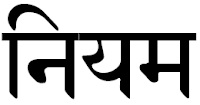This article is the second of a five part series based on this post: The Eight Limbs of Yoga (Part 2 – Niyama)
 The second of the five Niyamas is Samtosha (also Santosha) – a Sanskrit term meaning contentment or satisfaction. The word Samtosha is derived from the Sanskrit root word ‘tush’ which means to be satisfied, pleased, or delighted, as well as quiet or calm.
The second of the five Niyamas is Samtosha (also Santosha) – a Sanskrit term meaning contentment or satisfaction. The word Samtosha is derived from the Sanskrit root word ‘tush’ which means to be satisfied, pleased, or delighted, as well as quiet or calm.
Samtosha is an observance that is key to all the Niyamas for students and practitioners of Patanjali’s “classical” Yoga (Raja Yoga). Along with the other four Niyamas (observances or practices) it establishes the student or yogi’s self-training, dealing with their personal, inner world. Patanjali says of Samtosha: “From an attitude of contentment (samtosha), unexcelled happiness, mental comfort, joy, and satisfaction is obtained.” (Yoga sutra 2.42 – samtosha anuttamah sukha labhah)
Contentment is required for true peace of mind, yet we are challenged by a society and a culture that fosters its opposite – discontentment, especially in the western world. We are constantly bombarded by advertisements, commercials and other messages that make us feel inadequate and promote a steady grasping for material wealth, possessions and even sensual experiences. We are taught from early childhood to seek superficial gratification with little to no regard for future consequences for either ourselves or the world. All too easily we become attached to things or others to avoid facing our personal discomforts. We are mistakenly led to believe that by satisfying our cravings (as well as our egos), we will attain lasting happiness. But sadly, and to the contrary, ignorance, egotism, attachment, aversion and clinging to things that stimulate out senses pervade and actually become obstacles to contentment and any prospects for liberation.
So, this begs the question, what is contentment (Samtosha), and how can we incorporate it into our lives as an “observance”? Contentment is serenity, but not complacency; comfort, but not submission; reconciliation, not apathy; acknowledgment, but never aloofness. Contentment is a conscious decision, an ethical/moral choice, a step into the reality of the cosmos. Contentment/Samtosha is the inherent and natural state of our humanness and our Divinity and from this state our creativity and love flow. It recognizes our station and function in the universe at every moment. It is unity with the omniscient, omnipotent reality.
Observing Samtosha simply means that we remain contented in the midst of any situation we find ourselves in at any given time in our life, and if we slip into a state of discontentment then we need to practice returning to the state of Samtosha. There are certain pre-determined characteristic traits and tendencies that are hard or even impossible to change. A good example is our physical appearance; height, body makeup, facial features, skin color etc. are all things that cannot be easily changed. The problem however, is that many people are not contented with their appearance and will go to any length to look different or “better” than they really are. Efforts to change our natural appearance are actually cause for further discontentment, plus sometimes it can cause permanent or irreversible.
This isn’t just limited to physical appearance; many people are discontented with host of other personal faults and shortcomings, such as social status, financial situation, place of employment, etc. Examples of discontentment abound and with careful examination may be found in all spheres of our lives. But, it is also important to realize that being contented does not mean that we sit on our backsides and do nothing to improve our lot in life. In fact, when a person is genuinely contented, they would exhibit a natural zest and enthusiasm for life.
In the Bhagavad Gita (V.47-48) it is stated: “Your human right is for action only, never for the resulting fruit of actions. Do not consider yourself the creator of the fruits of your activities; neither allow yourself attachment to inactivity. Remaining immersed in union, perform all actions, forsaking attachment to their fruits, being indifferent to success and failure. This mental evenness is termed Yoga.”
In conclusion: By cultivating contentment (Samtosha) we promote the energies that alleviate suffering and turn ignorance into intelligence and wisdom. With practice, Samtosha will guide us toward fearless action, a deeper sense of community and a greater love for all sentient beings, thus putting all hearts at ease.

The next article will continue this series with: The Five Niyamas (Part 3 – Tapas)

